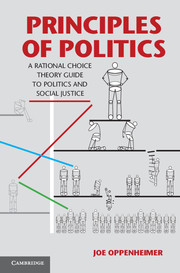Book contents
- Frontmatter
- Contents
- Propositions and Corollaries
- Tables
- Figures
- Sidebars
- Definitions
- Preface
- Overview of the Book
- Acknowledgments
- Introduction: Politics, Universals, Knowledge Claims, and Methods
- Part I The Logic of Collective Action
- Part II Collective Choice
- Part III Political Institutions and Quality Outcomes
- Part IV Social Justice, Choice, and Welfare
- Chapter 8 The General Problem of Collective Welfare and Choice
- Chapter 9 Voting Rules
- Chapter 10 Social Welfare and Social Justice: A Partial Integration
- Conclusions
- Bibliography
- Name Index
- Subject Index
Chapter 10 - Social Welfare and Social Justice: A Partial Integration
Published online by Cambridge University Press: 05 August 2012
- Frontmatter
- Contents
- Propositions and Corollaries
- Tables
- Figures
- Sidebars
- Definitions
- Preface
- Overview of the Book
- Acknowledgments
- Introduction: Politics, Universals, Knowledge Claims, and Methods
- Part I The Logic of Collective Action
- Part II Collective Choice
- Part III Political Institutions and Quality Outcomes
- Part IV Social Justice, Choice, and Welfare
- Chapter 8 The General Problem of Collective Welfare and Choice
- Chapter 9 Voting Rules
- Chapter 10 Social Welfare and Social Justice: A Partial Integration
- Conclusions
- Bibliography
- Name Index
- Subject Index
Summary
A sensible notion of social welfare does not come without some sort of interpersonally comparable well-being. On the other hand, collective choice rules can be designed to improve the chance that a democracy achieves good things for its citizens. But without being more specific in stipulating what constitutes social welfare, our measuring rod for identifying “good things” disappears just when we would wish to use it. Further, merely noting that interpersonal comparisons of individual well-being are needed to gain traction over social welfare doesn’t tell us how to make the comparisons. Without more details, how can we tie our notions of collective choice to social welfare? How are we to get around the problems Arrow identified? That is the focus of this chapter.
TO AGGREGATE OR NOT TO AGGREGATE: A FALSE DILEMMA
Arrow’s negative finding stems from his insistence that what is being aggregated are either individual preferences or something very similar to that: an indicator of well-being with ordinal properties of consistency but no basis for interpersonal comparisons. This is a relatively unfortunate, if realistic, assessment of the problem of social choice. After all, voting rules only aggregate some shadow of the rankings of proposals by voters in some way. To make a social choice, the rules aggregate very limited individual information. Any conception of social welfare must utilize a more complex mix of inputs than voting rules utilize.
- Type
- Chapter
- Information
- Principles of PoliticsA Rational Choice Theory Guide to Politics and Social Justice, pp. 223 - 244Publisher: Cambridge University PressPrint publication year: 2012



